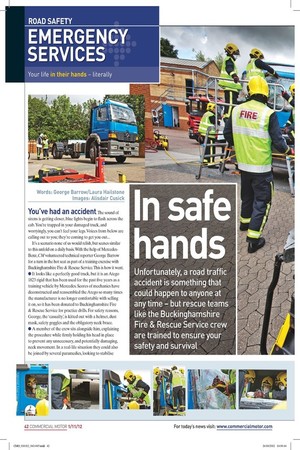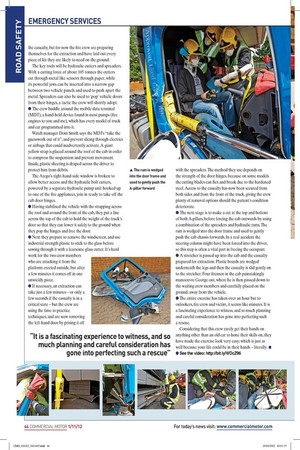ash across the In safe
Page 34

Page 36

Page 37

If you've noticed an error in this article please click here to report it so we can fix it.
hands
Unfortunately, a road traffic accident is something that could happen to anyone at any time – but rescue teams like the Buckinghamshire Fire & Rescue Service crew are trained to ensure your safety and survival
sirens g g gh gm cab. You’re trapped in your damaged truck, and worryingly, you can’t feel your legs. Voices from below are calling out to you; they’re coming to get you out...
It’s a scenario none of us would relish, but scenes similar to this unfold on a daily basis. With the help of MercedesBenz, CM volunteered technical reporter George Barrow for a turn in the hot seat as part of a training exercise with Buckinghamshire Fire & Rescue Service. This is how it went.
• It looks like a perfectly good truck, but it is an Atego 1823 rigid that has been used for the past five years as a training vehicle by Mercedes. Scores of mechanics have deconstructed and reassembled the Atego so many times the manufacturer is no longer comfortable with selling it on, so it has been donated to Buckinghamshire Fire & Rescue Service for practice drills. For safety reasons, George, the ‘casualty’, is kitted out with a helmet, dust mask, safety goggles and the obligatory neck brace.
• A member of the crew sits alongside him, explaining the procedure while firmly holding his head in place to prevent any unnecessary, and potentially damaging, neck movement. In a real-life situation they could also be joined by several paramedics, looking to stabilise the casualty, but for now the fire crew are preparing themselves for the extraction and have laid out every piece of kit they are likely to need on the ground.
The key tools will be hydraulic cutters and spreaders. With a cutting force of about 105 tonnes the cutters cut through metal like scissors through paper, while its powerful jaws can be inserted into a narrow gap between two vehicle panels and used to push apart the metal. Spreaders can also be used to ‘pop’ vehicle doors from their hinges, a tactic the crew will shortly adopt.
• The crew huddle around the mobile data terminal (MDT), a hand-held device found in most pumps (fire engines to you and me), which has every model of truck and car programmed into it.
Watch manager Dom Smith says the MDTs “take the guesswork out of it” , and prevent slicing through electrics or airbags that could inadvertently activate. A giant yellow strap is placed around the roof of the cab in order to compress the suspension and prevent movement. Inside, plastic sheeting is draped across the driver to protect him from debris. ▲ The ram is wedged The Atego’s right-hand-side window is broken to into the door frame and allow better access and the hydraulic bolt cutters, used to gently push the powered by a separate hydraulic pump unit hooked up A-pillar forward to one of the fire appliances, join in ready to take off the cab door hinges.
• Having stabilised the vehicle with the strapping across the roof and around the front of the cab, they put a line across the top of the cab to hold the weight of the truck’s door so that they can lower it safely to the ground when they pop the hinges and free the door.
• Next they prepare to remove the windscreen, and use industrial strength plastic to stick to the glass before sawing through it with a fearsome glass cutter. It’s hard work for the two crew members who are attacking it from the platform erected outside, but after a few minutes it comes off in one unwieldy piece.
• If necessary, an extraction can take just a few minutes – or only a few seconds if the casualty is in a critical state – but the crew are using the time to practice techniques, and are now removing the left-hand door by prising it off with the spreaders. The method they use depends on the strength of the door hinges, because on some models the cutting blades can flex and break due to the hardened steel. Access to the casualty has now been secured from both sides and from the front of the truck, giving the crew plenty of removal options should the patient’s condition deteriorate.
• The next stage is to make a cut at the top and bottom of both A-pillars, before forcing the cab outwards by using a combination of the spreaders and hydraulic rams. The ram is wedged into the door frame and used to gently push the cab chassis forwards. In a real accident the steering column might have been forced into the driver, so this step is often a vital part in freeing the occupant.
• A stretcher is passed up into the cab and the casualty prepared for extraction. Plastic boards are wedged underneath the legs and then the casualty is slid gently on to the stretcher. Four firemen in the cab painstakingly manoeuvre George out, where he is then passed down to the waiting crew members and carefully placed on the ground, away from the vehicle.
• The entire exercise has taken over an hour but to onlookers, fire crew and victim, it seems like minutes. It is a fascinating experience to witness, and so much planning and careful consideration has gone into perfecting such a rescue.
Considering that this crew rarely get their hands on anything other than an old car to hone their skills on, they have made the exercise look very easy; which is just as well because your life could be in their hands – literally. n • See the video: http://bit.ly/WDcZ96
THE CASUALTY’S POINT OF VIEW
A helmeted head appears in the right of my peripheral vision, its wearer’s eyes shielded by a golden visor. “Let’s get him out,” it says.
A pair of slightly flexible, plastic boards are quickly pushed beneath my thighs and a stretcher forced between them.
Almost simultaneously a dozen hands gently rotate my torso and slide me upwards, the awkward movement proving to be light relief from the dull ache in my neck brought on by having my head held motionless for a perceived eternity.
The hands hoist me into the air. I’m now horizontal, just inches from the cab roof. And then, as gravity forces the blood to surge into my head, daylight. I am reborn into the world from the passenger door of a Mercedes-Benz Atego.
I’ve just been rescued from a truck by the Buckinghamshire Fire & Rescue Service. Great Holm’s Blue Watch, to be more specific, who have stabilised me, reassured me, kept me safe and ultimately extracted me after a simulated accident scene.
While the drama of breaking glass, cutting doors and spreading cabs unfolded around me, my head was fixed straight ahead by a fireman’s firm grip and my body safely nestled under a polythene covering. Pebbles of glass have rained down upon me, cutters have crunched steel in front of my eyes and the sound of creaking metal has filled my ears, as the steering wheel in front of me is pushed away from my legs as if by magic.
Were this not a practice exercise it might have been a frightening experience, but Blue Watch has demonstrated a level of skill and professionalism we hope you’ll never experience. It should, however, be reassuring to know that if one of these golden-visored stormtroopers does appear in the corner of your eye, you are in very safe hands indeed.











































